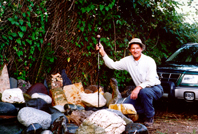Unlike most members of the Northwest Stone Sculptors Association, a few collect well over half of the stones that they carve. I have been within this minority since joining NWSSA (2001). In the last three months alone, I’ve sought stones for sculpting from Washington’s Whidbey and San Juan Islands, from California’s White, Argus, and Panamint Ranges, Jalama Beach, and Jade Cove, from Oregon’s Trout and Owyhee Ranges, and from Utah’s Raft River Range. In this two-part article, I give my reasons for seeking out so much carving material, provide useful tips for anyone wishing to take up collecting, and consider why, despite my enjoyment in finding the stones that I work, I’m increasingly open to sculpting purchased material.
So far as I can discern, my collecting for carving is impelled by five motives. It evokes warm memories of boyhood rock-hounding with family and friends. Moreover, it often satisfies my desire to experience out-of-the-way natural settings. In addition, it binds me to the resulting bounty through remembrances of the adventures of exploration and collection. It also gives me clues for learning about my found stones’ pathways from their formation long ago to my studio. Last, my collecting fulfills what may be a remnant of our species’ hunter-gatherer instinct. I suspect that others who seek out carving material are motivated by a similar set of feelings. However, I doubt that many of us do so to evade buying stones.
Finding one’s own rarely saves money.
My collecting sites are usually shorelines, river bars, deserts, and mountains. Unlike forests and fields, such places often have a profusion of rocks. But if you wish to search this abundance, do try to go when the conditions are favorable: to the shore when low tides occur in daylight hours and, ideally, after a storm has scoured away obscuring sand; to the river when its waters are so low that you can avoid the brushy banks; to the desert when the air is cool, the breeze moderate, and the ground no more than barely moist; and to the higher mountains when the snow is gone, the annual vegetation eaten back, and the mosquitoes scarce. Hence it was not by chance that my spring collecting areas were shorelines and desert ranges. While the rivers were up then and the snow fields only partially melted, the midday tides were good and the desert temperatures comfortable.
Even so, not all went as planned. My biggest surprise was in early May, when searching jasper in the Owyhee country of Oregon. I was caught in an intense downpour that, despite my four-wheel drive, mired me down on a remote yet graded dirt road. That evening, I hiked into tiny Rockville. Fortunately, good Samaritans there gave me a bed for the night, a big breakfast, and then help freeing my vehicle. Occasional kindnesses of this sort provide yet another incentive for collecting for carving!
